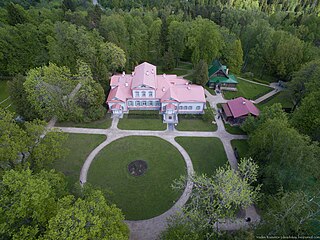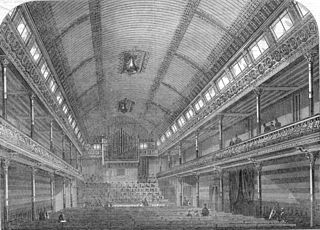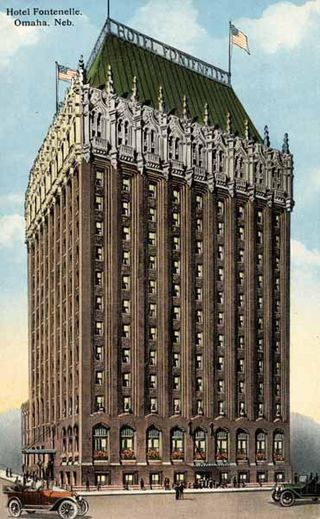Related Research Articles
Summer and Smoke is a two-part, thirteen-scene play by Tennessee Williams, completed in 1948. He began working on the play in 1945 as Chart of Anatomy, derived from his short stories "Oriflamme" and the then-work-in-progress "Yellow Bird." The phrase "summer and smoke" probably comes from the Hart Crane poem "Emblems of Conduct" in the 1926 collection White Buildings. After a disappointing Broadway run in 1948, the play was a hit Off-Broadway in 1952. Williams continued to revise Summer and Smoke in the 1950s, and in 1964 he rewrote the play as The Eccentricities of a Nightingale.

Abramtsevo is a former country estate and now museum-reserve located north of Moscow, in the proximity of Khotkovo, that became a centre for the Slavophile movement and an artists' colony in the 19th century. The estate is located in the village of Abramtsevo, in Sergiyevo-Posadsky District of Moscow Oblast. The Abramtsevo Museum-reserve site is an object of cultural heritage in Russia.

Goodspeed Musicals is a non-profit organization dedicated to the preservation and advancement of musical theater and the creation of new works, located in East Haddam, Connecticut. The landmark Goodspeed Opera House is a distinctive feature of the view from the Connecticut River and is the birthplace of some of the world's most famous musicals, including Annie, Man of La Mancha, and Shenandoah. Goodspeed Musicals also includes a smaller theater in Chester CT as well as several writing and performing seminars. Goodspeed Musicals is considered one of the foremost regional theaters in the United States to date producing 250 musicals, over 70 world premieres, and sending 21 productions to Broadway. Goodspeed Musicals is the first regional theatre in America to earn two special Tony Awards, one in 1980 for outstanding contributions to the American musical and a second in 1995 for distinguished achievement for a regional theatre.

The Academy of Music was a New York City opera house, located on the northeast corner of East 14th Street and Irving Place in Manhattan. The 4,000-seat hall opened on October 2, 1854. The review in The New York Times declared it to be an acoustical "triumph", but "In every other aspect ... a decided failure," complaining about the architecture, interior design and the closeness of the seating; although a follow-up several days later relented a bit, saying that the theater "looked more cheerful, and in every way more effective" than it had on opening night.

The Pence Opera House was an opera house and later, a mission, at Hennepin Avenue and 2nd Street in Minneapolis, Minnesota, United States.

John Sewell "Jack" Langrishe, popularly known as the "Comedian of the Frontier", was an Irish-American actor and impresario who travelled extensively throughout the American West and later in life became one of the first State Senators of Idaho.
The following is a list of neighborhoods and commercial districts in Sioux City, Iowa.

The Sioux City Municipal Auditorium, known as the Long Lines Family Recreation Center or Long Lines Auditorium for sponsorship reasons, is a multi-purpose facility in Sioux City, Iowa. The fifth in a line of major indoor venues built in Sioux City, it was designed by Knute E. Westerlind in 1938 and finally completed after many delays in 1950. In the building's original form, it was an arena that seated up to 3,500 people. In 2003, the building was replaced by the Tyson Events Center, built around the northeast corner of the Municipal Auditorium. The building was then converted to its current use as a recreation center while preserving the exterior building. The converted arena was originally named Long Lines Family Recreation Center, though in 2023 the building added the Long Lines Auditorium signing to the southeast entrance and inside the auditorium. The auditorium is referred to as either name.

St. George's Hall was a theatre located in Langham Place, off Regent Street in the West End of London. It was built in 1867 and closed in 1966. The hall could accommodate between 800 and 900 persons, or up to 1,500 persons including the galleries. The architect was John Taylor of Whitehall.

The history of Omaha, Nebraska, began before the settlement of the city, with speculators from neighboring Council Bluffs, Iowa staking land across the Missouri River illegally as early as the 1840s. When it was legal to claim land in Indian Country, William D. Brown was operating the Lone Tree Ferry to bring settlers from Council Bluffs to Omaha. A treaty with the Omaha Tribe allowed the creation of the Nebraska Territory, and Omaha City was founded on July 4, 1854. With early settlement came claim jumpers and squatters, and the formation of a vigilante law group called the Omaha Claim Club, which was one of many claim clubs across the Midwest. During this period many of the city's founding fathers received lots in Scriptown, which was made possible by the actions of the Omaha Claim Club. The club's violent actions were challenged successfully in a case ultimately decided by the U.S. Supreme Court, Baker v. Morton, which led to the end of the organization.

The Olympic Theatre, sometimes known as the Royal Olympic Theatre, was a 19th-century London theatre, opened in 1806 and located at the junction of Drury Lane, Wych Street and Newcastle Street. The theatre specialised in comedies throughout much of its existence. Along with three other Victorian theatres, the Olympic was eventually demolished in 1904 to make way for the development of the Aldwych. Newcastle and Wych streets also vanished.
William B. Fosser's puppet production Opera in Focus is a troupe which performs opera and musical theater with some of the world's most sophisticated puppets. The Opera in Focus puppet opera theater is located in Rolling Meadows, Illinois.
The Civic Opera Company (1922–1931) was a Chicago company that produced seven seasons of grand opera in the Auditorium Theatre from 1922 to 1928, and three seasons at its own Civic Opera House from 1929 to 1931 before falling victim to financial difficulties brought on in part by the Great Depression. The company consisted largely of the remnants of the Chicago Opera Association, a company that produced seven seasons of grand opera in the Auditorium Theatre from 1915 until its bankruptcy in 1921.

Alexander Saeltzer was a German-American architect active in New York City in the 1850s and 1860s. His work includes the Anshe Chesed Synagogue, Academy of Music, Theatre Francais, the Duncan, Sherman & Company building and the South Wing of the Romanesque revival structure at 425 Lafayette Street built between 1853 and 1881 as the Astor Library.
Boyd's Theater and Opera House was a theater and opera house at 1621 Harney Street in Downtown Omaha, Nebraska. It was demolished in 1920 and the property redeveloped for the then owner's department store business.

Crosby's Opera House (1865–1871) was an opera house in Chicago, Illinois, United States. It was founded by Uranus H. Crosby in 1865 with the goal of advancing the arts in Chicago by bringing opera to the city. The five-story building was designed by William W. Boyington and contained statues of painting, sculpture, music and commerce that welcomed visitors as they entered through the arch of the building. After holding only occasional performances, Crosby ran into many business difficulties that resulted in a decision to sell the building in 1866. The Crosby Opera House Art Association was formed to help Crosby sell the building by lottery. The lottery distributed over 210,000 tickets, awarding purchasers great works of art and even the building itself. After being sold back to Crosby by the lottery winner, A.H. Lee, the hall began producing more consistent performances. The opera house stood for less than six and a half years before it was destroyed in the Great Chicago Fire of 1871 and was never rebuilt.

The Broadway Theatre, called the Old Broadway Theatre since its demise, was at 326–30 Broadway, between Pearl and Anthony Streets in Lower Manhattan, New York City. With over 4000 seats, it was the largest theater ever built in New York when it opened. During its brief existence, many prominent performers of the era appeared on its stage. It presented plays, opera, ballet, hippodrama, and circus performances in a space that was reconfigured several times. The operators always struggled to make money, however, and after twelve years the Broadway Theatre was replaced by a more profitable building, for the textile trade.

Olympic Theatre was the name of five former 19th and early 20th-century theatres on Broadway in Manhattan and in Brooklyn, New York.
Arthur Samuel Garretson was an American banker, businessman, and politician in Sioux City, Iowa. Garretson had a part in several major aspects of Sioux City's growth. Garretson, South Dakota, was named after him.
References
- 1 2 3 4 Poole, Richard L. (1989). "Boosting Culture in the Gilded Age Sioux City Theater, 1870–1904". The Annals of Iowa. 50 (2–3): 130–157. doi: 10.17077/0003-4827.9380 . Retrieved July 31, 2022.
- 1 2 3 "Theatre". Sioux City Public Museum . Retrieved July 31, 2022.
- ↑ Peterson, Harold F. (1977). Diplomat of the Americas: A Biography of William I. Buchanan, 1852–1909. State University of New York Press. pp. 31–32. ISBN 978-0-87395-346-7 . Retrieved July 31, 2022.